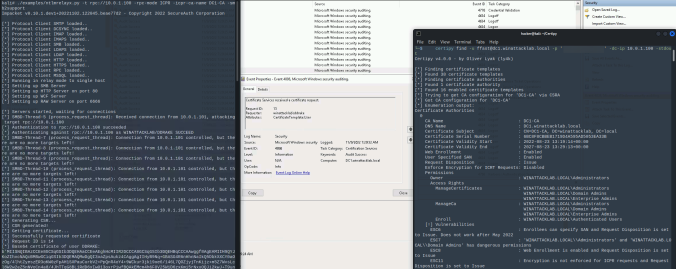Nowadays more and more security tools are used to monitor and generate alerts from different sources (EDR, Proxy, etc.).These alerts often contains URL, domain names, or file hashes that can and should be compared with a threat intelligence source to immediately identify current threats and avoid when possible false positives. In this article, we will […]
Compass Security Blog
Offensive Defense
Page 3 of 8
In June last year, the good folks at SpecterOps dropped awesome research on Active Directory Certificate Services (AD CS) misconfigurations. Since then, we find and report these critical vulnerabilities at our customers regularly. One of these new attack path is relaying NTLM authentication to unprotected HTTP endpoints. This allows an attacker to get a valid […]
More and more companies use Microsoft 365, well even we at Compass-Security use it internally. Moving to the cloud solves many issues that our DFIR team had to deal with in the past years. Managed infrastructure means no ProxyShell, Hafnium, etc. We’re grateful for that.
Email authentication and security is another complex topic that was often misconfigured in the past. We often could send phishing email in the name of our clients during assessments. Office 365 makes the life of scammers and phishers somehow harder. We’re also grateful for that.
However we still encounter some O365 environments where it’s possible to send spoofed emails. Why is that, you ask? We also wondered and dug into the O365 features and settings!
The ntds.dit file from a domain controller contains all password hashes of the domain. In a company with employees around the globe we were allowed to analyze the hashes. Here are the results, and the reason why you should implement a banned password list.
Passwordless products promise greater security and convenience by allowing users to log in to Windows systems with only their smartphone. But what is going on behind the scenes and how could a domain’s security stance be worsened by such a solution? In this post I will explain how these products are implemented and detail the vulnerabilities and weaknesses discovered in three tested products.
BloodHound is the way to go to for finding attack paths in an Active Directory (AD) environment. However, it is not always clear how the data is gathered without looking at the code of SharpHound, the data ingestor for BloodHound. Microsoft hardened their systems over time through updates, which makes enumeration of Active Directory (AD) […]
BloodHound is the way to go to for finding attack paths in an Active Directory (AD) environment. However, it is not always clear how the data is gathered without looking at the code of SharpHound, the data ingestor for BloodHound. Microsoft hardened their systems over time through updates, which makes enumeration of Active Directory (AD) […]
BloodHound is the way to go to for finding attack paths in an Active Directory (AD) environment. However, it is not always clear how the data is gathered without looking at the code of SharpHound, the data ingestor for BloodHound. Microsoft hardened their systems over time through updates, which makes enumeration of Active Directory (AD) […]
Agile software development models have become the de-facto standard. They are taught at universities and implemented in practice as far as possible. Anyone who doesn’t develop software using agile processes is on the verge, and already tilting towards that. At least that is how it seems. Consequently, the question is not whether the integration of […]
A little bit over a year ago, I wrote an article on this blog about CVE-2020-1113 and how it enabled to execute code on a remote machine through relaying NTLM authentication over RPC triggering a scheduled task on the remote system. History repeats itself and a vulnerability of the same category has been fixed by Microsoft in June this year.
© 2025 Compass Security Blog









